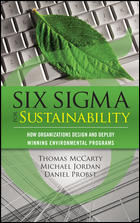Product Details
PROVEN STRATEGIES FOR CREATING CORPORATE SUSTAINABILITY PROGRAMS
Co-written by Six Sigma Black Belts and LEED Accredited Professionals, this pioneering guide reveals how to use the power of Six Sigma to develop and implement enterprise-wide green initiatives. Six Sigma Sustainability explains how typical Six Sigma DMAIC structures such as program governance, project charters, transfer functions, measurement systems, risk assessment, and process design support environmentally sound business practices.
Real-world examples demonstrate how specific problems in areas such as carbon emissions, energy conservation, materials recycling, water use, and finance can be solved using Six Sigma tools. The detailed information in this practical resource helps you to deliver innovative programs that simultaneously reduce environmental impact and create business value.
COVERAGE INCLUDES:
- Developing the business case for necessary investments in sustainability
- Sustainability leadership and the collaborative management model
- Applying the Six Sigma transfer function framework to identify critical drivers of success
- Sustainability measurement and reporting
- Designing a change management strategy and leveraging teams using the Six Sigma DMAIC framework
- Managing corporate real estate portfolios in compliance with green initiatives
- Case studies that show how to use Six Sigma methodologies to improve sustainability functions
- Design for Six Sigma--using the House of Quality and other essential Six Sigma design tools
- Stakeholder management--best practices for driving adoption of high quality solutions
Table of contents
Chapter 1. Developing the Business Case
Chapter 2. Sustainability and the Collaborative Management Model
Chapter 3. The Sustainability Transfer Function
Chapter 4. Sustainability Measurement and Reporting
Chapter 5. Transformational Change and the Power of Teams
Chapter 6. Sustainability and Real Estate
Chapter 7. Six Sigma Sustainability Project Examples
Chapter 8. Design for Six Sigma
Chapter 9. Stakeholder Management
Conclusion: Letters to Tomorrow's Corporate Leaders
Appendix A: Business Case Template and Examples
Appendix B: Sustainability Transfer Function
Appendix C: Sample Energy Conservation Opportunity Evaluation Checklist for an Office Building Assessment
Appendix D: Sample High-Level Process Map for Energy Conservation in an Office Facility
Appendix E: Sample Functional Performance Criteria for Enterprise Carbon Accounting Software
Index
Author comments
Tom McCarty, Six Sigma Master Black Belt, is a Managing Director within the Strategic Consulting group of Jones Lang LaSalle where he leads Six Sigma deployment strategies within the firm and for client engagements. He is the lead author of The Six Sigma Black Belt Handbook, and co-author of Six Sigma Financial Tracking and Reporting. Mr. McCarty's clients include HSBC, United Health Group, Fidelity, Sprint, Agilent, American Electric Power, Starbucks, Motorola, and the U.S. Department of Defense.
Michael Jordan is a Senior Vice President and leads Jones Lang LaSalle’s Energy and Sustainability Services (ESS) Americas Corporate practice. He has worked with real estate executives at Fortune Global 100 companies to cut costs, manage carbon, and build greener buildings worldwide. Mr. Jordan is a LEED Accredited Professional, a trained facilitator in The Natural Step sustainability framework, and a Six Sigma Master Black Belt.
Dan Probst has been in the commercial real estate industry for over thirty years including 23 with Jones Lang LaSalle. He currently serves as Chairman of the global Energy and Sustainability Services practice. He is responsible for developing and delivering products and services to help clients reduce energy costs and their real estate related environmental footprint through innovative portfolio and occupancy strategies, workplace standards, and operating practices. Dan has a Mechanical Engineering degree from Purdue University and an MBA from Indiana University, and is a LEED Accredited Professional.
